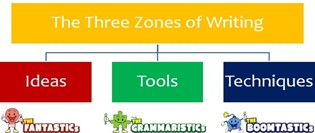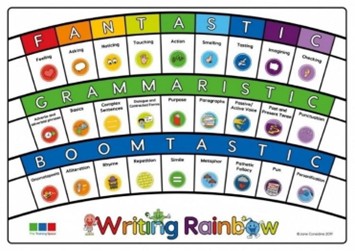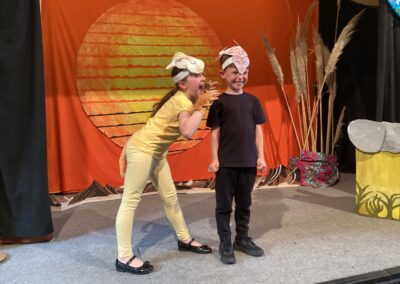Writing: Statement of Intent, Implementation & Impact
INTENT
At St. Peter’s C of E VA Primary School, we aim to develop a love of language in all our learners. We strive to create a positive writing culture in our school so that pupils find writing engaging and enjoyable, by providing exciting stimuli and purposes for writing. This helps children to understand the importance of writing as a life-long skill. It is our aim to enthuse, inspire and equip our pupils so they become confident, fluent writers who enjoy writing and can independently use the wide range of writing tools they have developed whilst on their writing journey with us. We believe effective composition of writing is dependent upon hearing and using high quality talk and ambitious vocabulary and as such we expose children to a wide range of high-quality texts, from a wide range of genres and subject areas. This encourages our pupils to have confidence in a range of writing styles, embedding ambitious vocabulary and effective grammar in their written work across the curriculum. Children learn to write clearly, accurately, and coherently, adapting their language and style in and for a range of contexts, purposes and audiences. Children learn to refine and edit their work independently over time as this is an important part of their growth in writing process. Our pupils are encouraged to take pride in the presentation of their writing by developing a neat, clear and joined, handwriting style by the time they move to secondary school.
IMPLEMENTATION
At St. Peter’s Brafferton, we ensure that all children see themselves as a writer and can take pleasure from the writing process. In line with the National Curriculum (2014), we ensure that all children are taught the grammar, punctuation and spelling objectives required for their year group by the time they leave each Key Stage. Early reading and writing are taught using the Read, Write Inc. Phonics scheme and following on from that, we use The Write Stuff by Jane Considine through to Year 6. We teach English as whole class lessons and use The Write Stuff to structure our sessions. Within lessons, teachers and teaching assistants target support wherever it is needed. This may involve a greater level of scaffolding, extra modelling or access to additional support materials such as word banks, phonics cards etc. or to extend thinking further and provide stretch. We set precise challenges to deepen the moment for pupils that are not simply based on writing more. The core concepts of writing (Composition, Fluency, Grammar and Punctuation) are taught through our daily English lesson. The core concepts of Spelling & Handwriting are taught discreetly but reinforced wherever possible within English sessions. Spelling is taught through the Read, Write Inc Spelling Scheme building upon early phonics, teaching spelling rules and National Curriculum statutory words. Handwriting is taught initially using Read, Write Inc and then progressing to a continuous cursive style from the end of Year 1 or beginning of Year 2, as outlined in our Handwriting Policy.
In our English lessons, teachers follow a repeated pattern of ‘Initiate’, ‘Model’ and ‘Enable’ whereby they use the three zones of writing to provide a consistent whole school systematic approach to writing carefully constructed sentences.


The Writing Rainbow
To be great writers, children need to know about The Three zones of Writing. These three essential components consist of: the FANTASTICs (Ideas); the GRAMMARISTICs (Tools); the BOOMTASTICs (Techniques).
These areas are vital to supporting the children through the writing process. Through the three zones of writing, we begin to take a systematic approach to helping the children very explicitly at every stage of their writing journey
The FANTASTICs system allows children to identify the nine elements that all text types are comprised of. When pupils are familiar with these nine elements, they can incorporate them into their writing. The FANTASTICs help children to sharpen their understanding of their own and others’ writing by encouraging them to be observant and reflective.
The 9 GRAMMARISTICs cover national curriculum requirements, capturing the broad spectrum of key grammar knowledge.

The BOOMTASTICs capture the ten powerful ways to add drama and poetic devices to writing. They help children structure their work, teaching them to showcase their writing voice, demonstrate originality and to take risks in a bid to capture the truth of a situation.
Following each unit taught, children plan and write an independent piece of linked to the unit they have completed. Through these pieces we are able to create a portfolio of independent writing which demonstrate the children’s independent use of skills taught. These pieces are assessed against The Write Stuff ‘Performance of Writing’ documents and the end of Key Stage national curriculum statements in Year 2 and Year 6.
Writing and presentation is highly valued across school and is celebrated in a variety of ways, such as in our weekly celebration assemblies for parents and displays within classrooms and across school. Each class aims to publish a whole or part of a piece of independent writing at least termly.
Narrative
Each text is revealed to the children either in full at the start of the unit, lesson by lesson to heighten the excitement and anticipation around the story or partly in the lesson and partly in reading sessions across the unit. In each lesson, however, the children focus on one moment at a time and consider the intent of each sentence. Children can map their sentences on to the plot point map and clearly identify whether a sentence has positive or negative intent.
Understanding the intent of a sentence allows children to make precise and deliberate choices with their vocabulary. Once children have followed their ‘central character’ through the story, they plan and write independently using their previous learning to shape their creative stories. Children are encouraged to see writing as a journey; re-drafting and editing are used before writing is published. Writing extends across the curriculum with children being given opportunities to write for a range of different purposes outside of the writing lesson.
Non-Fiction and Poetry
The teaching of non-fiction follows a similar structure to that of narrative, with one key difference – shapes.
Initially, children are taught to view each non-fiction text as a jigsaw puzzle. Each jigsaw piece represents a key feature of the text type, and each jigsaw piece is assigned a shape to help the children recall its purpose and position within the structure of the text. As children progress the jigsaw-like representation becomes a mental image to be used when they are trying to construct non-fiction writing independently. Writing extends across the curriculum with children being given opportunities to write for a range of different purposes outside of the writing lesson, for example holiday brochures in Geography
Greater Depth
When writing, all children are writing about the same plot point in the story at the same time. Any children who work quickly and are finished before others, are encouraged to ‘deepen the moment’. This involves the pupils writing more about the moment or plot point that they are on by enriching the plot with more detail or with different lenses.
SEND
All lessons across the curriculum are taught using Quality First Teaching and adaptations are made to ensure our curriculum is accessible for all pupils. Within writing, adaptations may include the use of IT to support handwriting, spelling and editing, the use of coloured overlays, pencil grips, writing slopes, scaffolded support within the initiate, model and enable sessions. SEN Support Plans outline any specific adaptations to allow pupils with additional needs to both access the sessions and achieve well. All staff consult these to ensure our provision matches specific need with targets being reviewed termly in consultation with staff, pupils and parents.
Feedback, Marking and Assessment
Feedback and marking are completed, where possible, within the lesson or as a close to the lesson as is feasible. All marking and feedback is given in line with our marking and feedback policy.
Assessment is an ongoing element of the teaching and learning of writing and takes place constantly: through the verbal feedback children receive during lessons and the questioning used to ascertain children’s understanding. The Write Stuff ‘Performance of Writing’ documents are a useful assessment tool that teachers use to help them when assessing children’s writing. The assessment of English also includes moderation of children’s writing which takes place within the school at staff meetings. All this is designed to ensure that class teachers have secure judgements of where their children are in relation to age related expectations and the statutory guidelines for Years 2 and 6.
A ‘Yearly Overview’ of the writing genres taught, both narrative and non-fiction, has been devised to show the variety of genres encountered by each cohort and the progression of skills from year to year. Writing units tend to take between two and four weeks to complete with the outcome of each unit being an independent piece of writing. These units are designed to motivate and inspire children, combining structured provision with exciting memorable experiences that elicit awe and wonder. Such related experiences include drama opportunities, handling artefacts, visits out, visitors to school etc.
IMPACT
At St. Peter’s all children can achieve success in writing, whatever their ability. Our pupils are inspired to write, to take pleasure in writing and most importantly, to see themselves as writers. The range of writing experiences we provide, enables all children to enjoy writing more, remember more and be able to produce more developed, mature pieces of writing.
By the time they leave St. Peter’s, our learners will be skilled at writing for different audiences and purposes. Our pupils will write well-presented, accurate and fluent pieces, including varied vocabulary, accurate spellings and grammatically correct structures.
We aim for the percentage of pupils working at age related expectations to be in line or better than national standards. Equally, we aim for the percentage of pupils working at greater depth will be in line or better than national standards.


